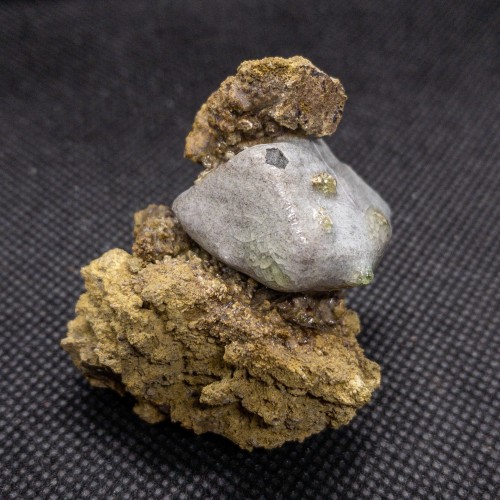#but this is a neat thing that needs explaining
Buchite on Scoria matrix
Locality: Emmelberg, Üdersdorf, Daun, Eifel, Rhineland-Palatinate, Germany
~~~~~~~~~~~~~~~~~~~~~~~~~~~~~~~~~~~~~~~~~~
“A compact, vesicular or slaggy metamorphic rock of any composition containing more than 20% vol. of glass, either produced by contact metamorphism in volcanic to subvolcanic settings or generated by combustion metamorphism.
An uncommon metamorphic rock type composed mostly of glass, formed by the melting of a sedimentary rock or soil by extreme heat from an adjacent lava flow or scoria eruption, or the burning of an underground coal bed. Buchite is a product of a special type of metamorphism, called pyrometamorphism (contact type, high to very high temperature, low pressure, often connected with coal fires). Buchites are often confused with obsidian, which is a volcanic glass rather than metamorphic glass. The so-called para-obsidian is a buchite with small amounts of mullite and tridymite forming microlites. Rarely, buchites can be colorful and transparent, and faceted as gemstones, as for example a few blue-green gems from the Eifel hills in Germany.
The original description of buchite was for partly fused, glassy sandstones associated with basalts (in Germany). Now the term also covers more pelitic rocks. The first described buchite contained relic, cracked quartz with tridymite overgrowths and inclusions, feathery or needle-like clinopyroxene, magnetite, cordierite crystals, tiny crystals of a spinel, small voids, pores interfilled with goethite and brown glass.
According to Grapes (2006), buchite also occurs as xenoliths and within contact aureoles.” - https://www.mindat.org/min-50131.html
Basically what this means for this rock, is that there was a scoria eruption (a volcanic eruption with lots of air bubbles in the magma) that came into contact with some sandstone. The intense heat of the magma was able to melt some of the sand, which then rapidly cooled and became glass. You can even still see the darker bands beneath the glassy layer, displaying this xenolith’s sedimentary origins!
This is my first time playing with the “Read More” function in order to provide some more information or an explanation, so please let me know if you read it and/or it is something you’d like to see more of in the future!
Post link

